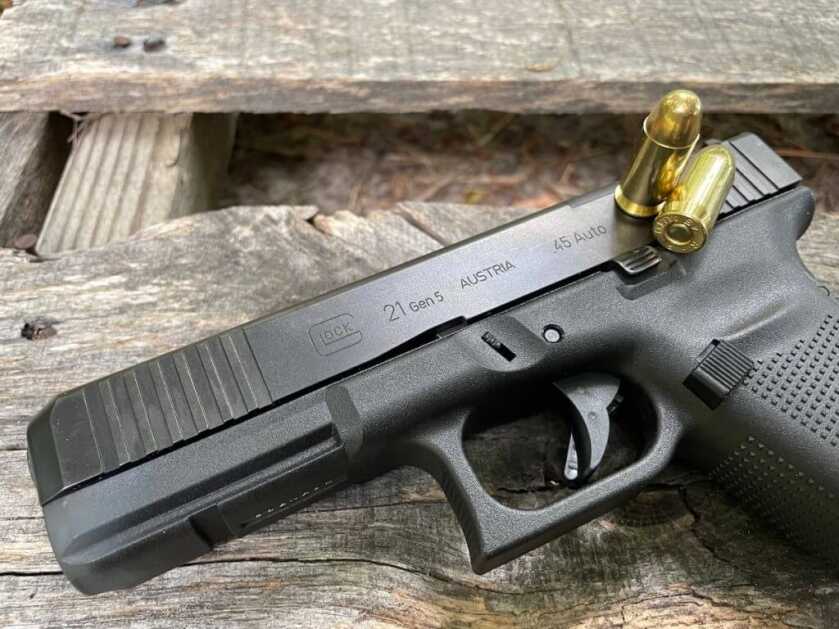
Glock has been bringing Gen5 enhancements to their big bore guns now that they have finished fleshing out their 9mm models with Gen5 technology. The .40 S&W was promoted to Gen5 status in 2021 and the G20 in 10mm Auto and the G21 in .45 Auto were ordained this year. So what’s the Gen5 goodness that the G21 received?
Estimated reading time: 10 minutes
Table of contents
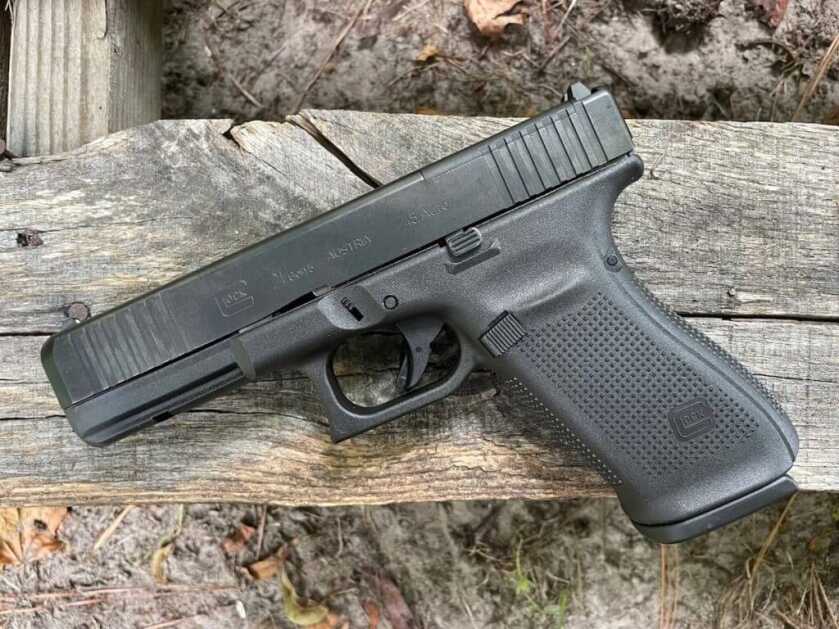
G21 is Optic Ready
The MOS or Modular Optic System allows the user to mount a red dot with really no specialized mechanical ability required. Adding an optic is a near guarantee that your group sizes will reduce. Besides you can’t offer a new pistol in the 21st century without the ability to mount a red dot.

Flared Magazine Well
Glock magazines are tapered so they have always been easier to reload faster than many other single- and double-stack magazines. The enlarged magwell now makes reloads even smoother and smooth translates to fast. The magazine floor plate is enlarged, too, making it easier to strip out the magazine should it get hung up inside the grip.
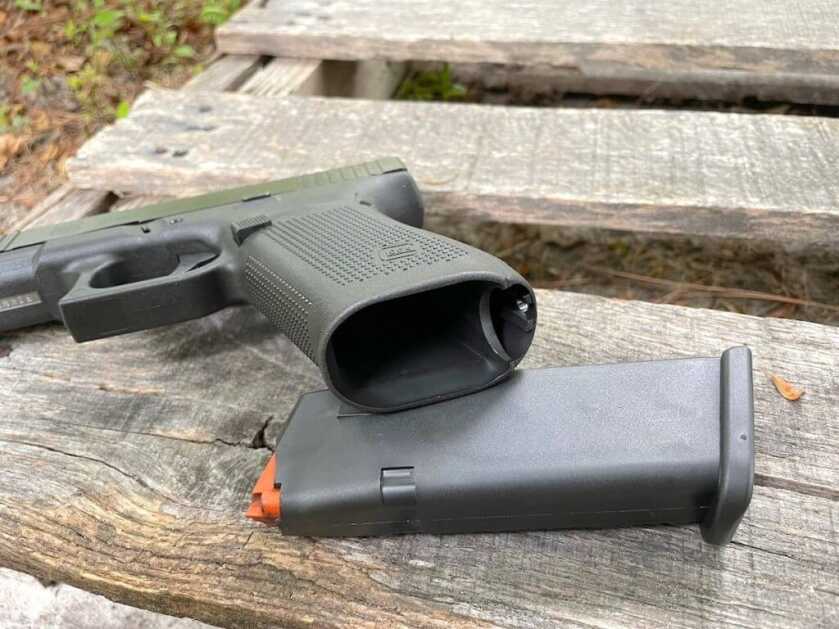
Glock Marksman Barrel (GMB)
The rifling in GMB barrels grabs bullets more aggressively so accuracy is better. Accuracy in Glock .45 Auto has always been very good and the new barrel rifling continues that trait.
Ambidextrous Slide Stop Levers
The slide release tabs are still small, but they are easy to manipulate and they don’t get in the way like oversized slide stops can.
Flat Front Grip Strap
Removing the finger grooves on the front grip strap was a good move. My grasp never really meshed up with the finger grooves on the Gen4 double stack .45 Auto pistols. For average hands, it never was a perfect fit, and for smaller hands, the pistol was too big. It’s a Goldilocks move for Glock that I’m glad they made. The back strap is also modular, like Gen4 guns, so if you want more girth and/or more beavertail, then the grip inserts will bulk up the pistol.
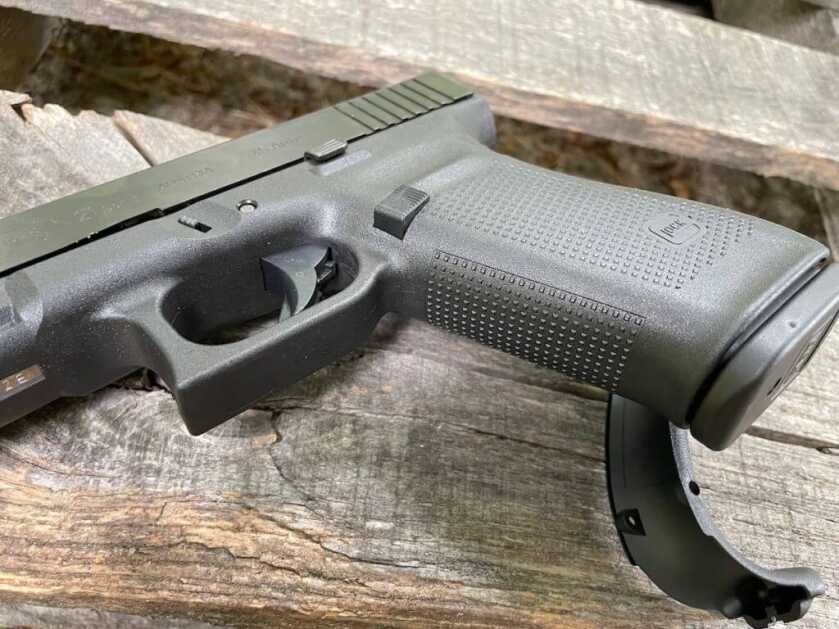
Chiseled Muzzle, Front Serrations
Older generation G21s had muzzles like a bulldozer, wide and flat. Blocky is the term used. The Gen5 G21 muzzle is tapered for ease when re-holstering the pistol. The straight serration grooves at the muzzle are appreciated especially when doing a press check.
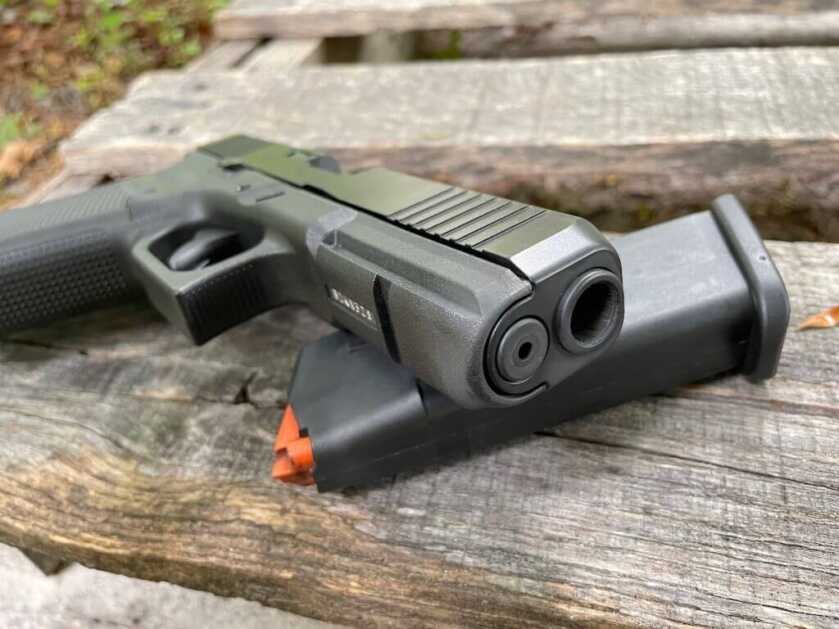
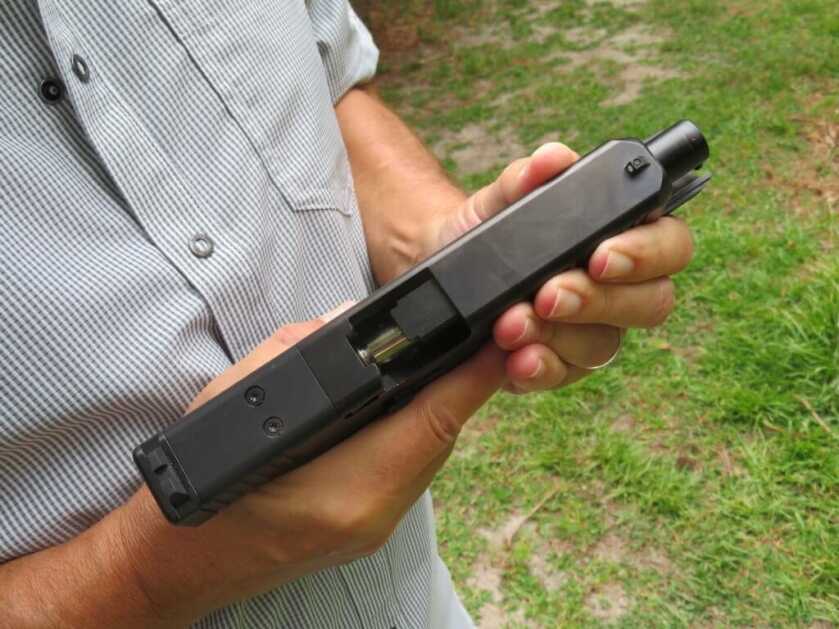
Better Bang Switch
Older-generation Glock triggers were neither loved nor hated. They were tolerated. Tolerated because they weren’t a crisp break like a tuned 1911 trigger, nor a smooth pull like a SIG P220. There was a squishy take-up and when you hit the wall some resistance until it broke with about 5.5 pounds of effort. Granted it was designed that way to replicate the press of a double-action revolver trigger. The Gen5 trigger is more what shooters have been asking. The take-up is a consistent resistance, then when you hit the wall, the resistance is shorter before the break. Reset feels like it is slightly less, too, than older generation triggers.
Are .45 Autos Still Relevant?
Forty-five caliber semi-automatics don’t get a lot of play these days since it has become a 9mm world. The 9mm caliber is the only caliber that matters when you are talking semi-auto pistols. Or does it? I have some LE pals that prefer the .45 Auto caliber. They’ve seen what a 9mm can do, and what a .45 Auto can do. They might carry 9mm in a duty gun, but for off-duty use, they prefer to carry a .45 Auto. I’ve run a few of the 9mm’s in Gen5 as well as a .40 Auto, but I was patiently waiting for an updated 5th Generation G21. My patience has been rewarded by all the 9mm chatter going these days.
If you are a 9mm fan you might want to skip this G21 Gen5 review. It’s a .45 caliber thing, you wouldn’t understand. But if you are curious about getting a .45 Auto pistol then, please continue reading.
Keep It Simple
When I think .45 Auto I first think 1911. These pistols have an excellent grip angle and the grip is thin. Some have exceptional triggers. They can also be temperamental if not maintained, and capacity is well, low, with seven- or eight-round magazines. I don’t want my magazines on a Keto diet. The SIG 220 is the second pistol I think of when I think of the .45 Auto. More sophisticated than a 1911, nice cycling slide, good accuracy, and a higher capacity. But it’s complicated. Kind of like your last relationship. There are safeties and decokers that require additional training. What I really want is simple and that’s where my third type of .45 Auto pistol comes in; the Glock 21. Safe, simple to use—aim, press trigger, shoot, repeat—simple. No safety levers to flip off. I like simple and Glock 21 delivers on that distinction.
Big Boy (And Girl) Caliber
The G21 has devoted followers since the model was introduced into Glock’s 2nd Generation series back in 1997. Finally, Glock had supersized their full-size pistol in a big boy (and girl) caliber. And super size it was. The grip girth was large and shooters with average size or smaller hands had a hard time shooting the pistol. A Short Frame or SF variant appeared in 2009 with Gen3 G21s. This reduced the trigger distance so you do not have to reach so far for the trigger with your finger. This tweak made the G21 infinitely easier to shoot for those of us with average and small size hands.
What really endears me to the Glock G21 is the 13-round magazine capacity, lightweight, and soft recoil. Fully stoked, the pistol weighs 38.6 ounces; a fully loaded 1911 weighs about 39.5 ounces but only has 8+1 rounds on board. For you cupcakes that flinch at the mere mention of recoil, the G21 offers a soft recoil due to the wide back strap which spreads out the felt recoil in your hand. Thin single-stack 1911s tend to focus recoil into the web of your hand and can get beat up quickly if you are burning through rounds.
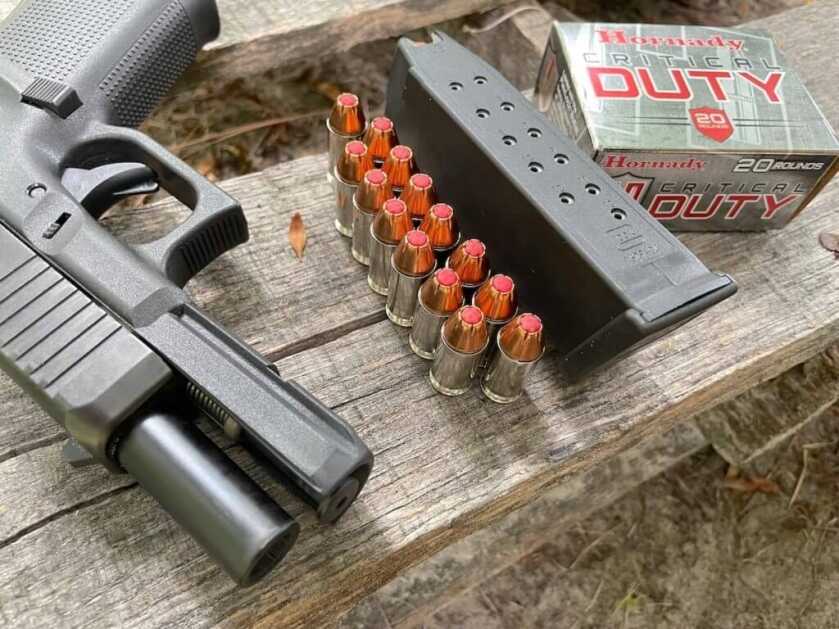
G21 Gen5 Range Time
Spoiler alert. The G21 Gen5 ran exceptionally. It went bang every time I pressed the trigger and this new generation G21 is just as accurate as other Glock .45 Auto’s I’ve fired in the past. Ammo consisted of both training and defense rounds: Winchester Defend with a 230-grain JHP, Remington UMC loaded with 230-grain FMJ bullets, and a hot .45 Auto +P Hornady Critical Duty load with a 220-grain FlexLock bullet. A nice assortment of defense and training ammunition.
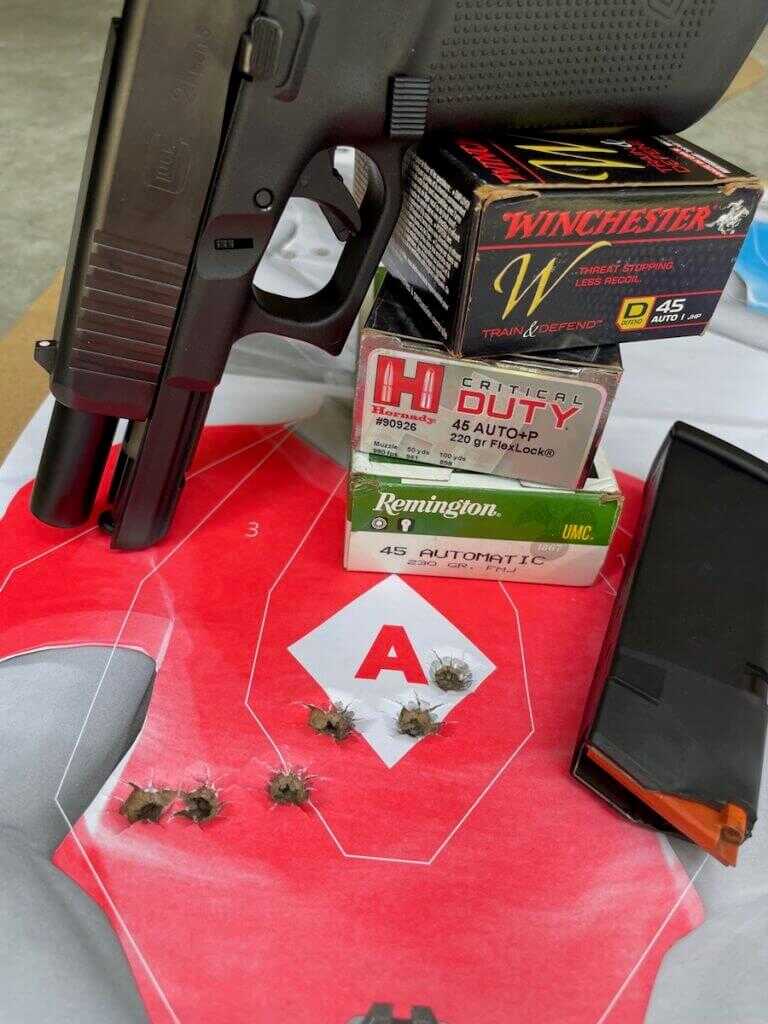
Even with the hot +P Hornady load the recoil from G21 felt soft. You cupcakes might pass on that load, but the 230-grain JHP and FJM rounds felt mild. The wide back strap helps stifle recoil as well as the polymer frame, which flexes slightly during recoil. The flat front grip strap and undercut trigger guard offer a lot of control when shooting for speed. I used an NRA D-1 tombstone-style target, the type used at GSSF matches set at 15 yards and I found myself eroding the center from the target. The slide cycle is not as snappy as it is with a .40 Auto and 10mm Auto.

Even though the grip on the G21 is larger in girth than one of the Glock 9mm double stacks, I could still manipulate the magazine release by slightly shifting the gun in my hand to perform reloads. Though the slide release is small it did my bidding, releasing the slide with a solid press with either my shooting hand thumb or support hand thumb.

Accuracy
Moving to 25 yards, I used my range bag as a rest to test accuracy. The smallest group measured 1.34 inches with Winchester Defend defense ammo. The hot Hornady +P load’s best group measured 2.04 inches. Inexpensive Remington UMC gave me a best group that measured 2.3 inches. Across all ammo, groups ranged from 1.35 inches to 2.3 inches. The G21 has the stuff.

Final Thoughts on the G21
After reviewing the G21 Gen5, I’m convinced the .45 Auto is still relevant today. It is still alive and mildly kicking. If you are looking for a full-size .45 Auto with a 13+1 round capacity for concealed carry, that won’t feel like a cement block tugging at your belt, the G21 is a great option. For me, the accuracy, mild recoil, lightweight, and legendary reliability provide peace of mind. The G21 Gen5 is just fine.
*** Buy and Sell on GunsAmerica! ***


The cool thing about the 45 ACP is when you suppress it. I think all 230 grain loads are subsonic and Hollywood quiet. Almost as much energy as the 220 grain 300 BLK.
The first Model 21s came out in late 1990/early 1991 and they were pretty good then. But the new Gen 5s (all models) seem to be about as good as good can possibly be.
Bought a Glock G21 10 or 12 years ago ( still have it) for the reason it was very simple to operate. No de-cocking or safety levers to manipulate. Used it at Front Sight 4 day defensive course putting close to 800 rounds through it, and yes it ate up my hands because of continuous holster draws, reloading, press checks, etc. I think the reason most people went to 9mm, including me, (Glock 17) was the price of ammunition. .45 was/is a lot more than 9mm, and 9mm is a lot more than .22LR. For defensive purposes high power hollow point 9mm will do the job I hope I never have to do. The rest is just practice and plinking.